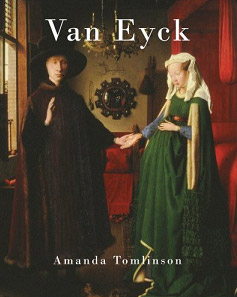
| HOME |
| NERVE |
| REVIEWS |
| ARCHIVE |
| EVENTS |
| LINKS |
| ABOUT US |
| CONTRIBUTORS |
| BACK ISSUES |
| CONTACT US |
 Van Eyck
Van Eyck
Amanda Tomlinson
Chaucer Press, hardback, £20
Available from 6th September 2007
Reviewed by Hana Leaper
Jan Van Eyck was born around 1390 into a Flemish painting dynasty. He began his career in the workshop of his elder brother Hubert, before overtaking him in fame and standing by gaining an appointment as a court painter for John of Bavaria, count of Hainaut, Holland in 1422. In 1425, he secured an even more prestigious appointment as court-painter to Philip the Good, Duke of Burgundy.
Although famed as the most influential and outstanding painter of the Northern Renaissance, not many works by Van Eyck survive, adding an enigmatic quality to the works that remain. There are other works attributed to him, and many copies of lost works undertaken by other painters, but his reputation as a European master of portrait painting rests on the survival of only a few signed and dated works from the last decade of his life. One of these works, 'The Arnolfini Portrait' c.1434, is so iconic that it is currently included in the opening sequence of popular television series Desperate Housewives, along with seven other fine art examples of 'domesticity and male-female relations throughout the centuries'. However, it has been mistakenly assumed that Arnolfini's wife, who is holding her sumptuous green gown to her belly, is pregnant. Simpson assures us that this is not the case and that her shape is distorted and swamped by the weight and mass of the heavy garment, typically worn by contemporary wealthy northern European women. This piece is extremely visually striking, not just for the fact, as Simpson details, that it is extremely rare to find a double portrait, possibly unique that the subjects are also both painted standing. What is of greatest interest – and this recurs in many of Van Eyck's pictures – is the almost repulsive ugliness of the couple, particularly Arnolfini. In contrast to his many pictures of Madonnas with child (he seems to have been prolific in portraying opaquely lovely, yet vacant images of motherhood), which are universally beautiful by the standards of any age, some of his portraits verge on grotesque.
This beautifully printed book presents an interesting, well-researched introduction to Van Eyck, with a fascinating introduction explaining in detail the few documented facts available about his early life and work, through to his most famous years. Particularly useful to the detail-hungry viewer, are the reproductions of smaller areas of each of the larger pieces – each panel from 'The Ghent Altarpiece’ is given a page.